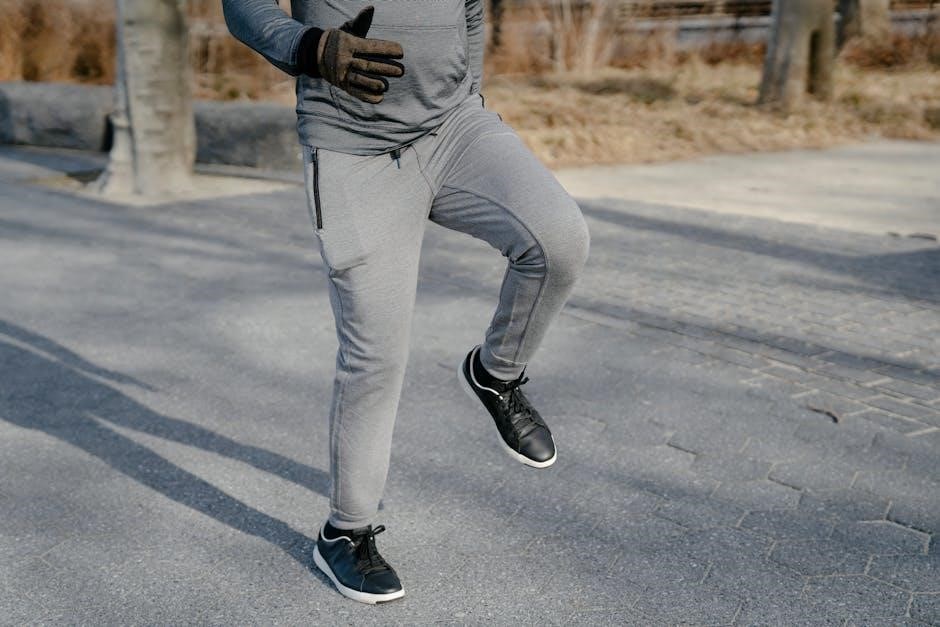
warm up exercises before running pdf
Warm-Up Exercises Before Running: A Comprehensive Guide
Preparing your body before a run is crucial for performance and injury prevention. This comprehensive guide explores the importance of warm-up routines, incorporating dynamic stretches to enhance flexibility and blood flow. Discover how to optimize your running experience with effective pre-run exercises.
Importance of Warming Up Before Running
Warming up before running is vital for preparing your body for the physical demands ahead. Many runners, especially when younger, might skip this crucial step, but a proper warm-up offers significant benefits, particularly as we age and experience increased stiffness. By gradually increasing blood flow to the muscles, warming up enhances flexibility and reduces the risk of injury.
A well-structured warm-up routine ensures that your muscles and joints are ready for optimal performance. This preparation allows for proper form during exercises, maximizing results and minimizing the potential for strains or other injuries. Dynamic stretches, a key component of a pre-run warm-up, increase core and muscle temperature, stimulating the nervous system and elongating muscles.
This proactive approach is especially important if you spend a significant portion of your day sitting, as prolonged inactivity can lead to stiffness. A comprehensive warm-up doesn’t have to be lengthy; a short routine consisting of targeted exercises can effectively prepare your body for a run. Incorporating dynamic movements like leg swings, high knees, and torso twists can significantly improve your running experience by promoting flexibility and reducing the risk of injury.
Benefits of a Proper Warm-Up
A proper warm-up before running offers a multitude of benefits, significantly enhancing both performance and safety. By increasing blood flow to the muscles, a warm-up ensures that they receive the necessary oxygen and nutrients for optimal function. This increased blood flow also improves muscle elasticity, reducing the risk of strains and tears;
Furthermore, a well-executed warm-up elevates core body temperature, which enhances enzyme activity and metabolic processes within the muscles. This leads to improved muscle power and efficiency, allowing you to run faster and longer with less effort. Preparing your cardiovascular system gradually for the increased demands of running is another key advantage. A warm-up allows your heart rate and breathing to increase steadily, preventing sudden stress on your body.
Beyond the physiological benefits, a proper warm-up also improves mental preparedness. Taking the time to focus on your body and engage in dynamic movements helps you mentally transition into your run, enhancing focus and reducing pre-run anxiety. By incorporating dynamic stretches and mobility exercises, you can improve your range of motion, which is crucial for maintaining proper running form and preventing injuries. Ultimately, a proper warm-up sets the stage for a more enjoyable and effective running experience, minimizing the risk of injury and maximizing performance.
Dynamic Stretching vs. Static Stretching for Pre-Run Warm-Up
The choice between dynamic and static stretching for a pre-run warm-up is crucial for optimizing performance and minimizing injury risk. Dynamic stretching, which involves active movements that take your joints and muscles through a full range of motion, is generally recommended before running. These movements increase blood flow, elevate muscle temperature, and improve flexibility in a way that mimics the demands of running.
Examples of dynamic stretches include leg swings, high knees, butt kicks, and torso twists. These exercises prepare your muscles and nervous system for the activity ahead, enhancing coordination and power. Static stretching, on the other hand, involves holding a stretch in a fixed position for an extended period. While static stretching can improve flexibility, it is generally not recommended before running.
Studies suggest that static stretching before exercise may actually decrease muscle power and performance. Holding a static stretch can temporarily reduce the muscle’s ability to contract forcefully, which can be detrimental to running. Static stretching is better suited for post-run cool-downs, when the muscles are already warm and pliable. In this context, static stretching can help improve flexibility and reduce muscle soreness. Prioritize dynamic stretches to prepare your body for the specific movements and demands of running.
Examples of Dynamic Warm-Up Exercises for Runners
Dynamic warm-up exercises are essential for preparing your body for the demands of running. These movements increase blood flow, improve flexibility, and activate the muscles you’ll be using during your run. Incorporating a variety of dynamic stretches into your pre-run routine can help prevent injuries and enhance performance.
One effective exercise is leg swings, which involve swinging your legs forward and backward, as well as side to side, to improve hip mobility. Walking lunges are another great option, engaging your quads, hamstrings, and glutes while improving balance and coordination. High knees, where you lift your knees towards your chest with each step, activate your core and hip flexors. Butt kicks, where you bring your heels towards your glutes, target your hamstrings and improve leg turnover.

Torso twists, performed by rotating your upper body from side to side, enhance core stability and spinal mobility. Each of these exercises should be performed for a set number of repetitions or for a specific duration, focusing on controlled movements and proper form. Remember to listen to your body and avoid pushing yourself too hard, especially when first starting out.
Leg Swings
Leg swings are a dynamic stretching exercise that effectively prepares the lower body for running by increasing flexibility and range of motion in the hips and hamstrings. This exercise helps to loosen up tight muscles and improve blood flow, reducing the risk of injury during your run.
To perform leg swings, stand tall with your feet shoulder-width apart and hold onto a stable object for balance if needed. Swing one leg forward and backward in a controlled motion, gradually increasing the range of motion as you feel comfortable. Avoid jerking or forcing the movement, focusing on smooth and fluid swings. Repeat this movement for 10-15 repetitions on each leg.
Next, perform side leg swings by swinging one leg out to the side and across your body, again in a controlled manner. This variation targets the inner and outer thigh muscles, further enhancing hip mobility. As with the forward and backward swings, perform 10-15 repetitions on each leg. Leg swings are a simple yet effective way to prime your muscles for running, contributing to a more efficient and enjoyable workout. Remember to maintain good posture and listen to your body throughout the exercise.
Walking Lunges
Walking lunges are a fantastic dynamic exercise to incorporate into your pre-run warm-up, targeting key running muscles such as the quadriceps, hamstrings, glutes, and calves. This exercise not only improves lower body strength and stability but also enhances flexibility and coordination, preparing your body for the demands of running.
To perform walking lunges, stand tall with your feet hip-width apart. Step forward with one leg, lowering your body until both knees are bent at approximately 90-degree angles. Ensure your front knee stays directly above your ankle and your back knee hovers just above the ground. Push off with your back foot and step forward, bringing your back leg through to become your leading leg, seamlessly transitioning into the next lunge.
Continue alternating legs, moving forward with each lunge. Maintain a straight back and engage your core throughout the exercise to maintain balance and stability. Aim for 10-12 lunges per leg, focusing on proper form and controlled movements. Walking lunges are an excellent way to activate your running muscles, increase blood flow, and improve your overall running performance while reducing the risk of injury. Remember to breathe deeply and listen to your body, stopping if you experience any pain.
High Knees
High knees are a dynamic warm-up exercise that effectively prepares your body for running by activating key muscles and improving coordination. This exercise primarily targets the hip flexors, quadriceps, and hamstrings, enhancing their flexibility and range of motion, which are essential for efficient running.
To perform high knees, stand with your feet hip-width apart and begin marching in place. As you march, focus on lifting each knee as high as possible towards your chest, ideally reaching waist level. Simultaneously, swing your arms in opposition to your legs, just as you would during a run. This arm movement helps to engage your core and improve overall coordination.
Maintain a brisk pace and focus on landing lightly on the balls of your feet with each step. Keep your torso upright and engage your core muscles to maintain balance and stability. Aim for 20-30 repetitions per leg, alternating legs with each step; High knees not only warm up your muscles but also improve your running form by promoting a higher knee lift and more powerful stride. This exercise helps to increase blood flow to the lower body, preparing your muscles for the demands of running and reducing the risk of injury. Remember to breathe deeply and maintain a controlled, rhythmic movement throughout the exercise.
Butt Kicks
Butt kicks are an excellent dynamic warm-up exercise that prepares the hamstrings and glutes for running. This exercise increases blood flow to the back of the legs, improving flexibility and reducing the risk of strains during your run.
To perform butt kicks, stand with your feet hip-width apart and your arms relaxed at your sides or bent at the elbows. Begin jogging in place, focusing on bringing your heels up towards your glutes with each step. The goal is to make contact between your heels and your buttocks, or get as close as possible. Simultaneously, swing your arms in opposition to your legs, maintaining a natural running motion. This helps to engage your core and maintain balance.

Keep your torso upright and avoid leaning forward. Focus on a quick, controlled movement, using your hamstrings to pull your heels up. Maintain a soft landing on the balls of your feet with each step. Aim for 20-30 repetitions per leg, alternating legs with each step.
Butt kicks not only warm up your hamstrings but also improve your running form by promoting a quicker cadence and more efficient stride. This exercise helps to activate the glutes, which are crucial for generating power during running. Remember to breathe deeply and maintain a steady rhythm throughout the exercise. By incorporating butt kicks into your warm-up routine, you can enhance your performance and minimize the risk of injury.
Torso Twists
Torso twists are a valuable dynamic warm-up exercise that targets the core muscles and improves spinal mobility. This exercise helps prepare the body for the rotational movements involved in running, enhancing balance and stability. Warming up the core is essential for efficient energy transfer and injury prevention.
To perform torso twists, stand with your feet shoulder-width apart, maintaining a slight bend in your knees. Extend your arms out to the sides, parallel to the ground, or bend your elbows and bring your fingertips to your shoulders. Keep your core engaged and your back straight.

Begin twisting your torso from side to side, rotating as far as comfortably possible without straining. Focus on rotating from your core, keeping your hips relatively stable and facing forward. Allow your arms to move with your torso, maintaining their position.
As you twist, exhale with each rotation to one side and inhale as you return to the center. This helps engage your core muscles and promote deeper rotation. Avoid jerky or rapid movements; instead, focus on smooth, controlled twists. Perform 15-20 repetitions on each side.
Torso twists not only warm up the core but also improve flexibility in the spine and surrounding muscles. This can help alleviate stiffness and improve your range of motion. Remember to maintain proper posture throughout the exercise. By incorporating torso twists into your warm-up routine, you can enhance core stability, improve running form, and reduce the risk of lower back pain.

How Long Should a Warm-Up Last?
Determining the ideal duration for a pre-run warm-up is crucial for optimizing performance and minimizing injury risk. Generally, a warm-up should last between 5 to 10 minutes, depending on the intensity and duration of the run you’re planning. The goal is to gradually increase your heart rate, body temperature, and blood flow to the muscles.
For shorter, easier runs, a 5-minute warm-up may suffice. This could involve light cardio, like jogging or brisk walking, followed by a few dynamic stretches. Focus on movements that mimic running, such as leg swings, high knees, and butt kicks, to prepare your muscles for the activity.
If you’re planning a longer or more intense run, such as a speed workout or hill repeats, a longer warm-up of 10 minutes is recommended. This allows for a more thorough preparation of your muscles and cardiovascular system. Include a wider variety of dynamic stretches to target different muscle groups.
Consider the ambient temperature as well. On colder days, a slightly longer warm-up may be necessary to ensure your muscles are adequately warmed. Listen to your body and adjust the duration based on how you feel. The warm-up should leave you feeling limber and ready to run, not fatigued.
Remember that consistency is key. Making warm-ups a regular part of your running routine will contribute to long-term injury prevention and improved performance.
Sample Warm-Up Routine for Runners
A well-structured warm-up routine prepares your body for the demands of running, reducing injury risk and enhancing performance. This sample routine incorporates dynamic stretches and light cardio to gradually increase your heart rate, body temperature, and muscle flexibility. Aim to spend 5-10 minutes completing these exercises before each run.
Begin with 2-3 minutes of light cardio, such as brisk walking or easy jogging. This elevates your heart rate and increases blood flow to your muscles.
Follow with dynamic stretches, performing each exercise for approximately 30 seconds:
- Leg Swings: Swing each leg forward and backward, then side to side, focusing on controlled movements.
- Walking Lunges: Step forward into a lunge, alternating legs with each step.
- High Knees: Lift your knees high towards your chest while walking or jogging in place.
- Butt Kicks: Kick your heels back towards your glutes while walking or jogging in place.
- Torso Twists: Gently twist your torso from side to side, keeping your feet planted.
Finish with a few strides, short bursts of faster running, to further prepare your muscles for the run ahead.
Remember to listen to your body and adjust the intensity and duration of each exercise as needed. This routine can be customized to suit your individual needs and preferences. Consistent use of this warm-up will improve your running experience.
Cool-Down After Running: The Importance of Static Stretching
Just as warming up prepares your body for exercise, cooling down is crucial for recovery and preventing injuries. Static stretching, holding a stretch for 20-30 seconds, is most effective after a run when your muscles are warm and pliable. This helps reduce muscle soreness, improve flexibility, and promote relaxation.
The cool-down process allows your heart rate and breathing to gradually return to normal. It also helps remove metabolic waste products from your muscles, reducing stiffness and soreness. Neglecting the cool-down can lead to muscle imbalances and increased risk of injury.
Focus on stretching major muscle groups used during running, including:
- Quadriceps: Stand and pull your heel towards your glutes, holding the stretch.
- Hamstrings: Sit with one leg extended and reach towards your toes.
- Calves: Lean against a wall with one leg extended behind you, feeling the stretch in your calf.
- Hip Flexors: Kneel with one leg forward and gently push your hips forward.
- Glutes: Lie on your back and pull one knee towards your chest, rotating your hip.
Remember to breathe deeply and avoid bouncing during static stretches. Hold each stretch for 20-30 seconds, repeating 2-3 times. Regular cool-down routines with static stretching will optimize your recovery and keep you running strong.
Related Posts

carrier comfortlink alarm codes pdf
Download the comprehensive Carrier ComfortLink alarm codes PDF guide for easy troubleshooting and system maintenance. Get instant access now!
squallywood pdf
Download Squallywood PDF instantly. Get your free copy now!

gottman worksheets for couples pdf
Strengthen your relationship with free Gottman worksheets for couples. Download printable PDFs based on research-backed strategies to improve communication and connection.